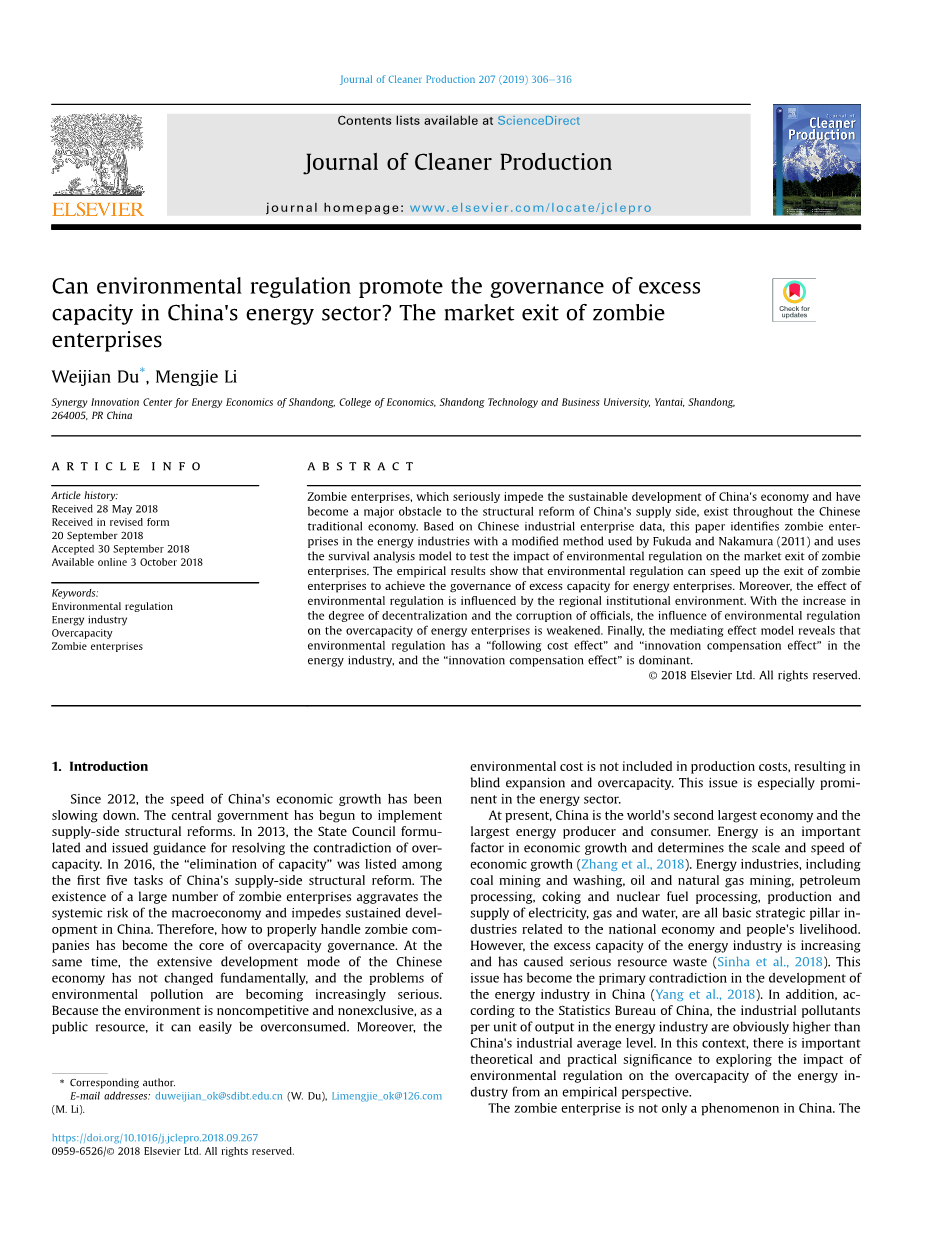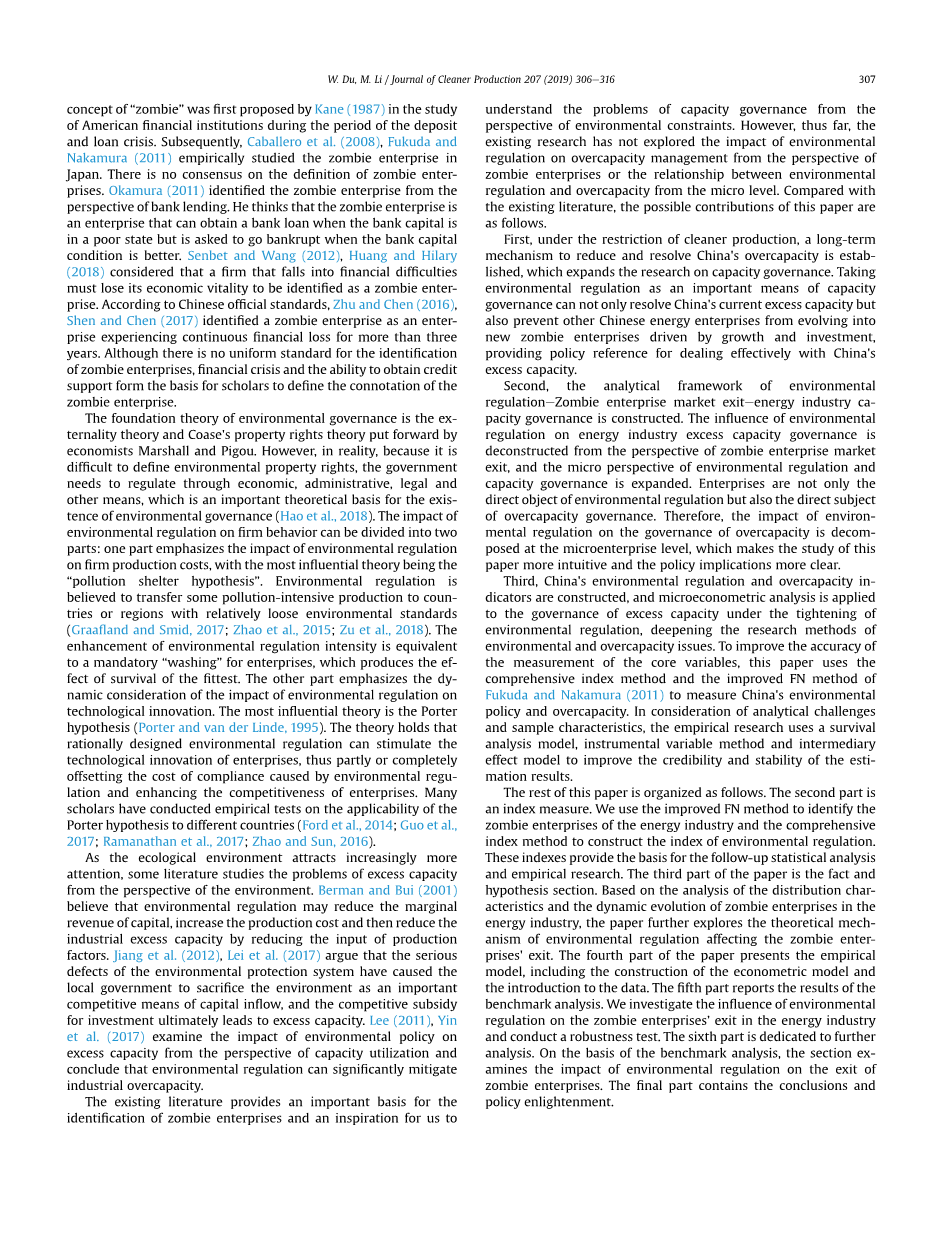

英语原文共 11 页,剩余内容已隐藏,支付完成后下载完整资料
5.2. Robustness of the environmental regulation index
To further verify the robustness of the environmental regulation variables in the benchmark model, the impact variables of Chinas environmental policy, pollutant discharge cost variables at the enterprise level and lag period of standard coal for total energy consumption are used in Table 3 as alternative indicators of envi-ronmental regulation. If the symbols and significance of environ-mental policy variables are consistent with the benchmark model,environmental regulation can achieve excess capacity governance by accelerating the exit of zombie enterprises in the energy in-dustry. In 1998, China implemented differential pollution regula-tion and territorial management through the division of the acid rain control area and the sulfur dioxide pollution control area (the“two controlled zones”1)[1]. In this paper, the sample is located in the“two control zone” policy implementation area. Therefore, in the regression analysis, the “two control zones” dummy variable 2[2] is introduced as the index of the environmental regulation policy. The Note: The LM statistic is used to detect the correlation between the instrumental variables and the endogenous variables. If the original hypothesis is rejected, the selection of the instrumental variables is credible, and the p values of the LM sta-tistics are in parentheses. The Wald F statistic is used to test whether the instru-mental variable has weak recognition, and if the original hypothesis is rejected, the selection of the instrumental variables is credible. Additionally, the critical value at the 10% level is noted in brackets. Rho represents the ratio of error variance to total error variance of enterprises unobservable heterogeneity, and the control variables are consistent with Table 2.
译文:
5.2.环境调节指标的稳健性
为了进一步验证基准模型中环境调控变量的稳健性,表3采用了我国环境政策影响变量、企业污染物排放成本变量和标准煤总能耗滞后期作为环境调控的替代指标。 如果环境政策变量的符号和意义与基准模型一致,环境监管可以通过加速能源行业僵尸企业的退出来实现过剩产能治理。 1998年,中国通过划分酸雨控制区和二氧化硫污染控制区(“两个控制区”1)实施了差别污染治理和区域管理 . 在本文中,样本位于“两个控制区”政策实施区域。 因此,在回归分析中,“双控制区”虚拟变量2[根据“双控制区”城市目录并与企业级数据匹配,如果企业位于“双控制区” ,虚拟变量接收值1,否则,它接收值0. ] 作为环境管制政策的指标。 注: lm 统计量用于检测工具变量和内生变量之间的相关性。 如果原始假设被否定,工具变量的选择是可信的,而且 lm 标准化的 p 值在括号中。 用 wald f 统计量来检验因变量是否具有弱识别性,如果原始假设被否定,工具变量的选择是可信的。 此外,10% 水平的临界值已在括号中注明。 Rho 代表企业不可观测异质性误差方差与总误差方差的比率,控制变量与表2一致。
results of the analysis are shown in model 1 of Table 3. The results show that the coefficient of the “two control zone” variable is positive and significant at the 1% level, indicating that environ-mental policy can improve the probability of the exit of zombie enterprises in the energy industry.
分析结果载于表3的模型1。 结果表明,“两个控制区”变量的系数在1% 水平上为正值且显著,说明环境政策可以提高能源行业僵尸企业的退出概率。
In addition, in view of the estimated deviation between the regional environmental regulation index and the enterprise data matching process, the enterprise-level emission fee collection in-dex is selected as the environmental regulation index to verify the robustness of the model conclusion, and the regression results are shown in model 2 of Table 3. The results show that the collection of corporate sewage charges can accelerate the exit of zombie enter-prises and have a positive impact on the governance of excess ca-pacity in the energy industry.
此外,针对区域环境规制指标与企业数据匹配过程的估计偏差,选取企业级排污收费指标作为环境规制指标,验证模型结论的稳健性,回归结果见表3模型2。 结果表明,企业排污费的征收可以加速僵尸企业的退出,对能源行业的过剩治理具有积极的影响。
In research on the impact of environmental regulation on the exit of zombie enterprises from the energy industry, the explana-tory variables are at the enterprise level, and the environmental regulation index is at the regional level. Although the possibility of reverse causation is low, other unobservable factors still cause endogeneity of the environmental regulation to some extent. We perform two-stage least squares (2SLS) regression analysis and select the lag one phase of the total energy consumption standard coal in China as an instrumental variable of environmental regu-lation (Fu and Li, 2010). The results are shown in model 3 of Table 3. The regression results of the 2SLS method show that the coefficient of the environmental regulation variable is significantly positive; that is, environmental policy can improve the overcapacity of en-ergy enterprises to a certain extent. In addition, the LM statisticsand Wald F statistics reject the correlation between the instru-mental variables and the endogenous variables and the original assumption that the instrumental variables have weak identifica-tion at the 1% significant level, which verifies the effectiveness of the instrumental variables.
在研究环境规制对僵尸企业退出能源产业的影响时,解释变量为企业层面,环境规制指数为区域层面。尽管逆向因果关系的可能性较低,但其他不可观测因素仍在一定程度上造成了环境规制的内生性。我们采用两阶段最小二乘(2sls)回归分析,选择能耗总量标准煤的滞后一阶段作为环境调整的工具变量(fu and li,2010)。结果如表3的模型3所示。2sls 方法的回归结果表明,环境管制变量的系数显著正,即环境政策能够在一定程度上改善能源企业的产能过剩。此外,lm 统计学和 wald 统计学拒绝了内生变量和内容变量之间的相关性,以及原来工具变量在1% 显著水平上识别较弱的假设,这证明了工具变量的有效性。
5.3. Environmental regulation and excess capacity management:the perspective of fiscal decentralization and local official corruption in China
5.3. 环境监管与产能过剩管理: 财政地方分权与地方官员腐败的视角
Whether environmental regulation can be effectively transmitted, guaranteed, implemented and supervised will be directly related to whether the pollution behavior of enterprises can be better suppressed. However, fiscal decentralization and local official corruption are important factors impacting the effective-ness of environmental regulation. Due to the decentralization of the central government and the local government (Song and Jin, 2016) and local official corruption (Liao et al., 2017), the questions of whether government policy is consistent with reality and whether an enterprise can fully meet the standard of environmental regu-lation will affect the effectiveness of the environmental regulation.As indicators of fiscal decentraliza
剩余内容已隐藏,支付完成后下载完整资料
资料编号:[234265],资料为PDF文档或Word文档,PDF文档可免费转换为Word


